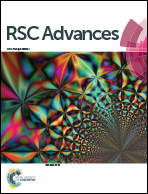Carboxymethylcellulose films containing chlorhexidine–zirconium phosphate nanoparticles: antibiofilm activity and cytotoxicity†
Abstract
In this paper sodium carboxymethylcellulose (SCMC) films containing chlorhexidine (CLX) loaded into layered zirconium phosphate (ZrP) nanoparticles were prepared with the aim of obtaining wound dressings with antibiofilm activity but reduced cytotoxicity. CLX, which is a broad spectrum antimicrobial agent, unfortunately with high cytotoxicity, was intercalated between the layers of ZrP in order to prolong and localize its release and thus to improve its safety. The intercalated product, ZrP(CLX), was characterized by X-ray powder diffraction (XRPD), transmission electron microscopy (TEM) and thermogravimetric analysis (TGA) which revealed a good drug loading (ca. 50% w/w). CLX release from the intercalated product was evaluated as well. Then SCMC composite films containing CLX were prepared and characterized. All films (both films containing neat CLX and intercalated CLX) showed good antimicrobial and antibiofilm activity. As concerns cytotoxicity, it was evaluated using human keratinocytes and fibroblasts. When CLX was intercalated in ZrP, its cytotoxicity was significantly reduced, confirming the potential use of ZrP in drug delivery advanced medical applications.


 Please wait while we load your content...
Please wait while we load your content...